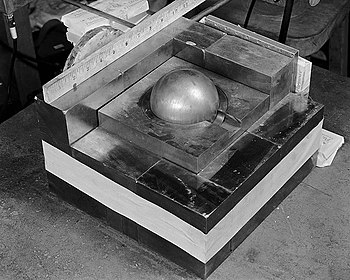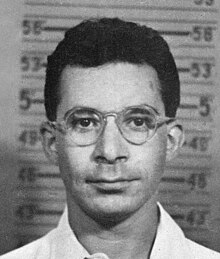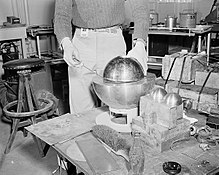Demon Core
Demon Core
Demon Core: The Unused Third Atomic Bomb of WW2
Critical Mass in nuclear fission reactions
What can go wrong when you tickle the dragon's tail.
Critical Mass in nuclear fission reactions
What can go wrong when you tickle the dragon's tail.
Re: Demon Core

A re-creation of the 1945 criticality accident
using the Demon core:
a plutonium pit is surrounded
by blocks of neutron-reflective tungsten carbide.
The original experiment was designed to measure
the radiation produced when an extra block was added.
The mass went supercritical
when the block was placed improperly
by being dropped.
Larger Image
Use of a neutron reflector
Surrounding a spherical critical mass with a neutron reflector further reduces the mass needed for criticality.
A common material for a neutron reflector is beryllium metal.
This reduces the number of neutrons which escape the fissile material, resulting in increased reactivity.
Use of a tamper
In a bomb, a dense shell of material surrounding the fissile core will contain, via inertia, the expanding fissioning material. This increases the efficiency.
A tamper also tends to act as a neutron reflector. Because a bomb relies on fast neutrons (not ones moderated by reflection with light elements, as in a reactor), the neutrons reflected by a tamper are slowed by their collisions with the tamper nuclei, and because it takes time for the reflected neutrons to return to the fissile core, they take rather longer to be absorbed by a fissile nucleus. But they do contribute to the reaction, and can decrease the critical mass by a factor of four.
Also, if the tamper is (e.g. depleted) uranium, it can fission due to the high energy neutrons generated by the primary explosion. This can greatly increase yield, especially if even more neutrons are generated by fusing hydrogen isotopes, in a so-called boosted configuration.
Surrounding a spherical critical mass with a neutron reflector further reduces the mass needed for criticality.
A common material for a neutron reflector is beryllium metal.
This reduces the number of neutrons which escape the fissile material, resulting in increased reactivity.
Use of a tamper
In a bomb, a dense shell of material surrounding the fissile core will contain, via inertia, the expanding fissioning material. This increases the efficiency.
A tamper also tends to act as a neutron reflector. Because a bomb relies on fast neutrons (not ones moderated by reflection with light elements, as in a reactor), the neutrons reflected by a tamper are slowed by their collisions with the tamper nuclei, and because it takes time for the reflected neutrons to return to the fissile core, they take rather longer to be absorbed by a fissile nucleus. But they do contribute to the reaction, and can decrease the critical mass by a factor of four.
Also, if the tamper is (e.g. depleted) uranium, it can fission due to the high energy neutrons generated by the primary explosion. This can greatly increase yield, especially if even more neutrons are generated by fusing hydrogen isotopes, in a so-called boosted configuration.
Re: Demon Core

Slotin's Los Alamos badge photo
Born Louis Alexander Slotin
1 December 1910
Winnipeg, Manitoba, Canada
Died 30 May 1946 (aged 35)
Los Alamos, New Mexico
Cause of death Acute radiation syndrome
Occupation Physicist and chemist
Known for Criticality tests on Plutonium & nuclear weapons assembling, the Dollar unit of reactivity
Criticality accident
A re-creation of the Slotin incident. The inside hemisphere with the thumb-hole next to the demonstrator's hand is beryllium (replacing the uranium tamper of the same size in a Fat Man bomb). There is an external larger metal sphere of aluminium under it (replacing the pusher sphere in this bomb's design). The plutonium "demon core" was inside the spheres at the time of the accident and is not visible, but its dimensions are comparable with the two small half-spheres shown resting nearby.
On 21 May 1946, with seven colleagues watching, Slotin performed an experiment that involved the creation of one of the first steps of a fission reaction by placing two half-spheres of beryllium (a neutron reflector) around a 3.5-inch-diameter (89 mm) plutonium core. The experiment used the same 6.2-kilogram (13.7 lb) plutonium core that had irradiated Harry Daghlian, later called the "demon core" for its role in the two accidents. Slotin grasped the upper 228.6 mm (9-inch) beryllium hemisphere with his left hand through a thumb hole at the top while he maintained the separation of the half-spheres using the blade of a screwdriver with his right hand, having removed the shims normally used. Using a screwdriver was not a normal part of the experimental protocol.
At 3:20 p.m., the screwdriver slipped and the upper beryllium hemisphere fell, causing a "prompt critical" reaction and a burst of hard radiation. At the time, the scientists in the room observed the blue glow of air ionization and felt a heat wave. Slotin experienced a sour taste in his mouth and an intense burning sensation in his left hand. He jerked his left hand upward, lifting the upper beryllium hemisphere and dropping it to the floor, ending the reaction. He had already been exposed to a lethal dose of neutron radiation. At the time of the accident, dosimetry badges were in a locked box about 100 feet (30 m) from the accident. Realizing that no one in the room had their film badges on, "immediately after the accident Dr. Slotin asked to have the badges taken from the lead box and placed on the critical assembly". This peculiar response was attributed to "vertigo" and was of no value for determining the actual doses received by the men in the room.
Others in the room at the time included Raemer E. Schreiber, Alvin Cushman Graves, Stanley Allan Kline, Marion Edward Cieslicki, Dwight Smith Young, Theodore P. Perlman, and Pvt. Patrick J. Cleary.
As soon as Slotin left the building, he vomited, a common reaction from exposure to extremely intense ionizing radiation. Slotin's colleagues rushed him to the hospital, but the radiation damage was irreversible.
By 25 May 1946, four of the eight men exposed during the incident had been discharged from hospital. The Army doctor responsible for the hospital, Captain Paul Hageman, said that Slotin's, Graves', Kline's and Young's "immediate condition is satisfactory."
A re-creation of the Slotin incident. The inside hemisphere with the thumb-hole next to the demonstrator's hand is beryllium (replacing the uranium tamper of the same size in a Fat Man bomb). There is an external larger metal sphere of aluminium under it (replacing the pusher sphere in this bomb's design). The plutonium "demon core" was inside the spheres at the time of the accident and is not visible, but its dimensions are comparable with the two small half-spheres shown resting nearby.
On 21 May 1946, with seven colleagues watching, Slotin performed an experiment that involved the creation of one of the first steps of a fission reaction by placing two half-spheres of beryllium (a neutron reflector) around a 3.5-inch-diameter (89 mm) plutonium core. The experiment used the same 6.2-kilogram (13.7 lb) plutonium core that had irradiated Harry Daghlian, later called the "demon core" for its role in the two accidents. Slotin grasped the upper 228.6 mm (9-inch) beryllium hemisphere with his left hand through a thumb hole at the top while he maintained the separation of the half-spheres using the blade of a screwdriver with his right hand, having removed the shims normally used. Using a screwdriver was not a normal part of the experimental protocol.
At 3:20 p.m., the screwdriver slipped and the upper beryllium hemisphere fell, causing a "prompt critical" reaction and a burst of hard radiation. At the time, the scientists in the room observed the blue glow of air ionization and felt a heat wave. Slotin experienced a sour taste in his mouth and an intense burning sensation in his left hand. He jerked his left hand upward, lifting the upper beryllium hemisphere and dropping it to the floor, ending the reaction. He had already been exposed to a lethal dose of neutron radiation. At the time of the accident, dosimetry badges were in a locked box about 100 feet (30 m) from the accident. Realizing that no one in the room had their film badges on, "immediately after the accident Dr. Slotin asked to have the badges taken from the lead box and placed on the critical assembly". This peculiar response was attributed to "vertigo" and was of no value for determining the actual doses received by the men in the room.
Others in the room at the time included Raemer E. Schreiber, Alvin Cushman Graves, Stanley Allan Kline, Marion Edward Cieslicki, Dwight Smith Young, Theodore P. Perlman, and Pvt. Patrick J. Cleary.
As soon as Slotin left the building, he vomited, a common reaction from exposure to extremely intense ionizing radiation. Slotin's colleagues rushed him to the hospital, but the radiation damage was irreversible.
By 25 May 1946, four of the eight men exposed during the incident had been discharged from hospital. The Army doctor responsible for the hospital, Captain Paul Hageman, said that Slotin's, Graves', Kline's and Young's "immediate condition is satisfactory."
Dollar unit of reactivity
According to Weinberg and Wigner, Slotin was the first to propose the name dollar for the interval of reactivity between delayed and prompt criticality;
0 is the point of self-sustaining chain reaction, a dollar is the point at which slowly released, delayed neutrons are no longer required to support chain reaction, and enters the domain called "prompt critical".
Stable nuclear reactors operate between 0 and a dollar; excursions and nuclear explosives operate above a dollar. The hundredth part of a dollar is called a cent (reactivity). When speaking of purely prompt critical events, some users refer to cents "over critical" as a relative unit.
According to Weinberg and Wigner, Slotin was the first to propose the name dollar for the interval of reactivity between delayed and prompt criticality;
0 is the point of self-sustaining chain reaction, a dollar is the point at which slowly released, delayed neutrons are no longer required to support chain reaction, and enters the domain called "prompt critical".
Stable nuclear reactors operate between 0 and a dollar; excursions and nuclear explosives operate above a dollar. The hundredth part of a dollar is called a cent (reactivity). When speaking of purely prompt critical events, some users refer to cents "over critical" as a relative unit.
Re: Demon Core
Tickling the Dragon's Tail

A re-creation of the Slotin incident.
The inside hemisphere with the thumb-hole next to the demonstrator's hand is beryllium
(replacing the uranium tamper of the same size in a Fat Man bomb).
There is an external larger metal sphere of aluminium under it
(replacing the pusher sphere in this bomb's design).
The plutonium "demon core" was inside the spheres at the time of the accident and is not visible,
but its dimensions are comparable with the two small half-spheres shown resting nearby.
Larger Image

A re-creation of the Slotin incident.
The inside hemisphere with the thumb-hole next to the demonstrator's hand is beryllium
(replacing the uranium tamper of the same size in a Fat Man bomb).
There is an external larger metal sphere of aluminium under it
(replacing the pusher sphere in this bomb's design).
The plutonium "demon core" was inside the spheres at the time of the accident and is not visible,
but its dimensions are comparable with the two small half-spheres shown resting nearby.
Larger Image
Re: Demon Core
I enjoyed reading about this piece of history and the ethical tug of war in the minds of those scientists.
Oppenheimer's story of the trinity test makes you feel like you are reliving the moment.
The connection he makes to the Bhagavad Gita is nothing short of amazing. The quote has been engrained in my head since playing Civilization 4 years ago.
A youtuber made a funny comment on the Demon Core incidents. He says it's the physicist equivalent of "hold my beer and watch this" .
Oppenheimer's story of the trinity test makes you feel like you are reliving the moment.
The connection he makes to the Bhagavad Gita is nothing short of amazing. The quote has been engrained in my head since playing Civilization 4 years ago.
A youtuber made a funny comment on the Demon Core incidents. He says it's the physicist equivalent of "hold my beer and watch this" .
Re: Demon Core
Of course it is. It's what people do so often. Usually doesn't end well after a few passes. False confidence.Royal wrote: A youtuber made a funny comment on the Demon Core incidents. He says it's the physicist equivalent of "hold my beer and watch this" .
This is somewhat equivalent to using sticks of dynamite as firecrackers.
Re: Demon Core
Leave it to Richard Feynman to call it "Tickling the Dragon's Tail".
Re: Demon Core
The Santa Susana Field Laboratory is a complex of industrial research and development facilities located on a 2,668-acre (1,080 ha) portion of the Southern California Simi Hills in Simi Valley, California. It was used mainly for the development and testing of liquid-propellant rocket engines for the United States space program from 1949 to 2006, nuclear reactors from 1953 to 1980 and the operation of a U.S. government-sponsored liquid metals research center from 1966 to 1998.
The site is located approximately 7 miles (11 km) northwest from the community of Canoga Park and approximately 30 miles (48 km) northwest of Downtown Los Angeles. Sage Ranch Park is adjacent on part of the northern boundary and the community of Bell Canyon along the entire southern boundary.
https://en.wikipedia.org/wiki/Santa_Sus ... Laboratory
The site is located approximately 7 miles (11 km) northwest from the community of Canoga Park and approximately 30 miles (48 km) northwest of Downtown Los Angeles. Sage Ranch Park is adjacent on part of the northern boundary and the community of Bell Canyon along the entire southern boundary.
https://en.wikipedia.org/wiki/Santa_Sus ... Laboratory
Re: Demon Core
The Fission Process
In the nucleus of each atom of uranium-235 (U-235) are 92 protons and 143 neutrons, for a total of 235. The arrangement of particles within uranium-235 is somewhat unstable and the nucleus can disintegrate if it is excited by an outside source. When a U-235 nucleus absorbs an extra neutron, it quickly breaks into two parts. This process is known as fission (see diagram below). Each time a U-235 nucleus splits, it releases two or three neutrons. Hence, the possibility exists for creating a chain reaction.
MIT Link
In the nucleus of each atom of uranium-235 (U-235) are 92 protons and 143 neutrons, for a total of 235. The arrangement of particles within uranium-235 is somewhat unstable and the nucleus can disintegrate if it is excited by an outside source. When a U-235 nucleus absorbs an extra neutron, it quickly breaks into two parts. This process is known as fission (see diagram below). Each time a U-235 nucleus splits, it releases two or three neutrons. Hence, the possibility exists for creating a chain reaction.
MIT Link

The MIT Research Reactor is used primarily for the production of neutrons. When it is in operation, the central active core contains a huge number of neutrons traveling in every direction at very high speeds.
The rate of fissions in the uranium nuclei in the MIT reactor is controlled chiefly by six control blades of boron-stainless steel which are inserted vertically alongside the fuel elements. Boron has the property of absorbing neutrons without re-emitting any. When the control blades are fully inserted, they absorb so many neutrons from the uranium that there are not enough to allow a chain reaction to continue. To put the reactor into operation, the control blades are raised very slowly. As fewer and fewer neutrons are absorbed, more and more neutrons are available to cause the splitting of uranium nuclei, until finally enough neutrons are available to sustain a chain reaction.
In the MIT reactor, one other group of components is essential to the maintaining and controlling a chain reaction. Since U-235 nuclei do not readily absorb the high energy neutrons that are emitted during fission, it is necessary to slow the neutrons down with a "moderator". Three types of moderators are used at the MIT reactor: (1) ordinary or "light" water that is also used to cool the reactor core, (2) deuterated or heavy water (D20), and (3) high-purity graphite, both of which are excellent at slowing neutrons without absorbing them.
The rate of fissions in the uranium nuclei in the MIT reactor is controlled chiefly by six control blades of boron-stainless steel which are inserted vertically alongside the fuel elements. Boron has the property of absorbing neutrons without re-emitting any. When the control blades are fully inserted, they absorb so many neutrons from the uranium that there are not enough to allow a chain reaction to continue. To put the reactor into operation, the control blades are raised very slowly. As fewer and fewer neutrons are absorbed, more and more neutrons are available to cause the splitting of uranium nuclei, until finally enough neutrons are available to sustain a chain reaction.
In the MIT reactor, one other group of components is essential to the maintaining and controlling a chain reaction. Since U-235 nuclei do not readily absorb the high energy neutrons that are emitted during fission, it is necessary to slow the neutrons down with a "moderator". Three types of moderators are used at the MIT reactor: (1) ordinary or "light" water that is also used to cool the reactor core, (2) deuterated or heavy water (D20), and (3) high-purity graphite, both of which are excellent at slowing neutrons without absorbing them.